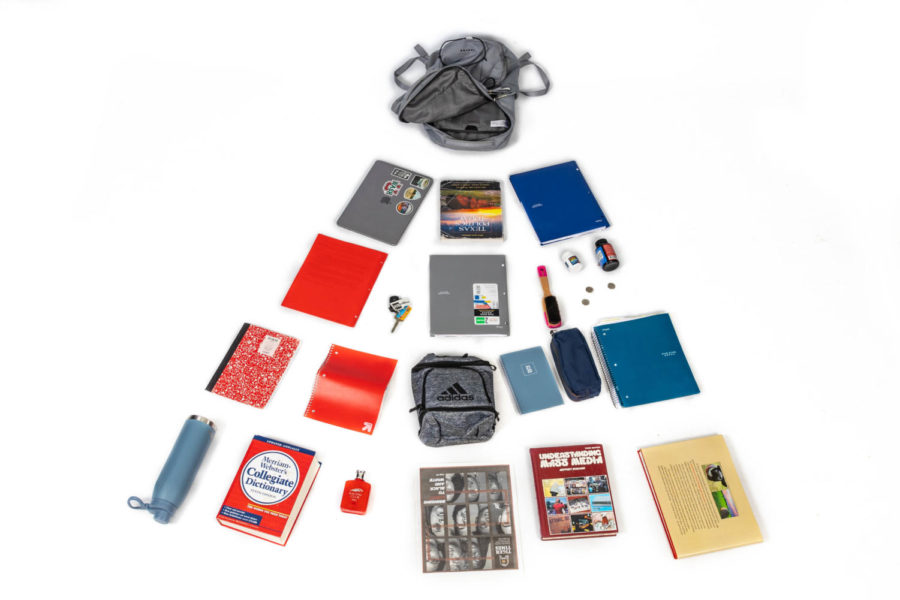Students, not suspects
Widespread drug searches lead to ruined futures, distrust between administrators and students
Photo by Sydney Rowe
Rates of students and their bags being searched has increased exponentially in March.
May 12, 2022
TISD’s goal is to create a “trusting, supportive and mutually respectful environment.”
I believe the above-mentioned “objective” listed in the TISD Mission Statement page is a principle that is not always heeded here at Texas High School. For how can students feel trusted, respected and supported by an administration that has increased spending by thousands in order to bring forth a campaign against drugs that has taken students in the most difficult times of their lives out of the learning environment and into courtrooms?
For the students of our school, guilty or not, the recent occurrences of police and trained drug dogs making their way through our halls has facilitated an environment of fear and distrust.
Should a student develop a habit of using illegal substances, there are a number of questions school staff ought to ask before “how can we catch them?” Consider the home life of these individuals, the pressures that brought them to this unhealthy coping mechanism and most especially the ways staff may be able to steer these students on the right path. The counseling center is surely a quicker path back to healthy learning than prosecution and punishment.
Consider, this year TISD will spend an estimated $1,279,639 on Guidance and Counseling according to their Fiscal Year Budget 2021-2022, available online. How many students could avoid stains on their records, that they will carry with them for the rest of their lives, should there be a counseling stage between apprehension of minor drugs instead of a direct path to legal action?
Administrators, so much depends on the acceptance of a common fact: those using minor drugs in school aren’t a danger to the students you are supposed to protect, they are exactly who require your protection the most. The assumption that those abusing substances like marijuana are beyond help and must be turned over to the authorities is a mentality that goes hand in hand with the mass incarceration of nonviolent drug offenders. These students’ status as minors is fading quickly, making this the time in their lives a last chance for intervention before they enter a substantially less friendly world.
This isn’t to say that drugs aren’t bad; they inherently are, and I won’t waste my time attempting to convince anyone else otherwise. However, there’s an important distinction to be made between the crimes students are committing and the students themselves.
Let me introduce you to Tom, (a pseudonym for an upperclassman whose story many students are familiar with) who was one of many who had their vehicles searched on Thursday, March 31. In his car, searched after the drug dog alerted, school administrators found unspecified amounts of Schedule I drugs. The amounts were indicative of possession, not an intent to sell; it’s clear then that this individual is obviously distressed and has developed extremely dangerous habits in order to cope.
Nonetheless, the student was removed from school and has been since the incident. This student has missed days of education for substances done outside of the school environment. But this is nothing compared to the effects that are to come.
In an interview with Tom, he detailed the fear that surrounded his arrest on April 12. He knew it would happen, just not when. After 12 days in DAEP, the officers came.
Now he waits for a trial, which will be held approximately four months from his arrest. Tom’s future plans were to attend Texarkana College, using the hours he built up in high school through the dual credit program to get most of his basic courses out of the way, and eventually transfer to a larger university to finish a degree in computer science.
Tom was fairly popular, and his detention is widely known across school. In a discussion among classmates on his recent detainment, his former teacher was surprised to have heard of his drug use, stating “he didn’t seem like that kind of kid at all.” This is exactly my point; drugs aren’t indicative of any one type of person, rather, they are a result of stressors of one’s environment. Anyone is susceptible.
In this way, I believe the actions of administrators and their decision to pursue students in this way are conducive to their failure of Tom, who likely could have been approached and offered healthier ways to deal with the issues that have led him to drug use in the first place. If a student denies this help completely, and needs to be “scared straight” (however statistically false and ignorant the method is), what would be the harm of attempting a more supportive solution first?
It’s exactly this mentality that I write against today: it’s not necessarily an argument against administrators protecting the safety of students but against the objective of using whatever means possible to convict and remove as many students as possible for whatever drugs they are found with.
Marijauna, though it carries no comparable risk of car accidents or overdoses, is deemed worthy of conviction all the same as hard drugs. Note of course, federal legalization of the substance has already passed the U.S. House of Representatives, yet here at Texas High it’s seen as worthy of legal punishment. It seems our country is moving in a progressive direction, while administrators are chasing the opposite goal, ramping up the convictions of students caught using these substances.
We are long past last decade’s demonization of weed users and our school is caught in the past if they disagree. No one should advocate for marijuana use among minors, but arguably the effects of targeting these students as criminals are worse for the students than the drug themselves.
As an individual, you have the right to hate drugs; you even have the right to hate the people who do them. However, as an administrator, one’s priority is on the protection and promotion of students; one’s personal, political or religious bias against substances cannot be allowed to subvert the original mission statement of the job.
I believe, along with many others, that the school’s recent campaign against drugs is the antithesis of the principles they ought to follow, should their goal truly be the one their mission statement of creating a “caring environment” with a “wide range of opportunities” claims.
The opinions reflected in the article are my own, and not reflective of the Tiger Times as a whole.















